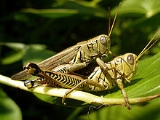
Differential grasshopper
Encyclopedia
The differential grasshopper (Melanoplus differentialis) is a species of grasshopper belonging to the genus Melanoplus
found throughout northern Mexico, central United States and southern Ontario, Canada. It is considered a pest in most of its range.
except for the east coast and northwest. Within its range the M. differentialis is most often found in heavily weeded areas and grasslands, they can even be spotted in vacant lots and other urban areas. This species is not migratory but can travel within a few miles to search for food.
), Common sunflower (Helianthus annuus
), Prickly lettuce (Lactuca serriola
). Adults can pick up on a chemical change in wilted lettuce and sunflowers and will tend to avoid these plants.
) but it strongly out numbers it in the southern portion.
Melanoplus
Melanoplus is a large genus of grasshoppers. They are the typical large grasshoppers in North America...
found throughout northern Mexico, central United States and southern Ontario, Canada. It is considered a pest in most of its range.
Description
Adult males grow to 28–37 mm and females grow to 34–50 mm. They are brownish or greenish and as they age the color will darken. There are black grooves on the pronotum. The male has bootlike appendages at the end of its abdominal tip. There are inverted chevrons along the hind femur and the hind part the tibia is yellowish with black spikes. All of the adults tarsi are yellow along with its antennae, which in some cases are reddish yellow.Range and habitat
Found throughout most of the United StatesUnited States
The United States of America is a federal constitutional republic comprising fifty states and a federal district...
except for the east coast and northwest. Within its range the M. differentialis is most often found in heavily weeded areas and grasslands, they can even be spotted in vacant lots and other urban areas. This species is not migratory but can travel within a few miles to search for food.
Life cycle
An adult female will lay up to 8 egg masses in soft soil, each of these masses can contain up to 11 eggs. Once these eggs are laid about 54% of them will hatch in about 2 weeks. There is only one generation a year which occurs in early summer. Once they hatch the nymphs take around 32 days to become complete adults. Adults are most active during the summer while the larvae are active in the spring. It is polyphagous, eating both grasses and forbs but experiments have shown that they grow faster if fed forbs. The most favored food plants tend to be Giant ragweed (Ambrosia trifidaAmbrosia trifida
Common names: Buffalo Weed, Great Ragweed, Giant Ragweed, Bitterweed, Bloodweed, Horse Cane, Tall AmbrosiaAmbrosia trifida is an annual plant in the aster family, native throughout much of North America. Its flowers are green and are pollinated by wind rather than by insects, and the pollen is one...
), Common sunflower (Helianthus annuus
Sunflower
Sunflower is an annual plant native to the Americas. It possesses a large inflorescence . The sunflower got its name from its huge, fiery blooms, whose shape and image is often used to depict the sun. The sunflower has a rough, hairy stem, broad, coarsely toothed, rough leaves and circular heads...
), Prickly lettuce (Lactuca serriola
Lactuca serriola
Prickly Lettuce is an annual or biennial plant, slightly foetid, that is commonly considered a weed of orchards, roadsides and field crops. The closest wild relative of cultivated lettuce , it grows throughout the temperate regions of all major continents. The leaves grow along a spiny stem and...
). Adults can pick up on a chemical change in wilted lettuce and sunflowers and will tend to avoid these plants.
Agricultural problems
The young will feed upon various grains, alfalfa and hay crops while the adults will attack the corn, cotton and deciduous fruit crops. A single swarm can often deplete a younger crop to nothing in a matter of a few days. Because this species has a tendency to stay in large swarms while eating, it is a serious issue for farmers in most of its range. In the northern part of the range it is joined equally in numbers by the Two-striped grasshopper (Melanoplus bivittatusMelanoplus bivittatus
The Two-striped Grasshopper is a species of grasshopper belonging to the genus Melanoplus. It is considered a pest species to the United States and Canada....
) but it strongly out numbers it in the southern portion.
External links
- Melanoplus differentialis, Univ. of Wyoming
- Melanoplus differentialis, Discover Life
- Orthoptera (grasshoppers, katydids, crickets) of Ojibway, Ojibway Nature Centre

